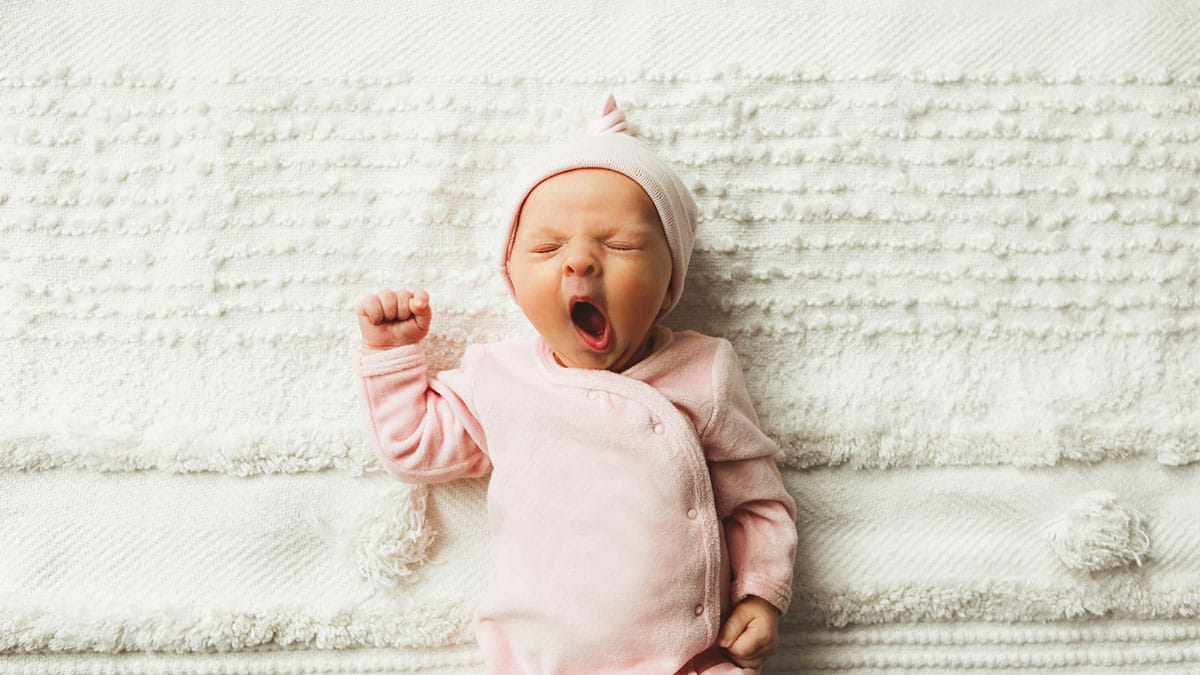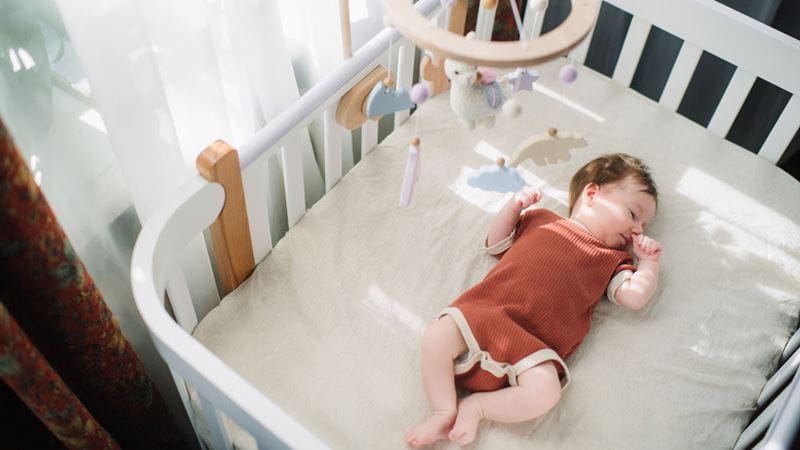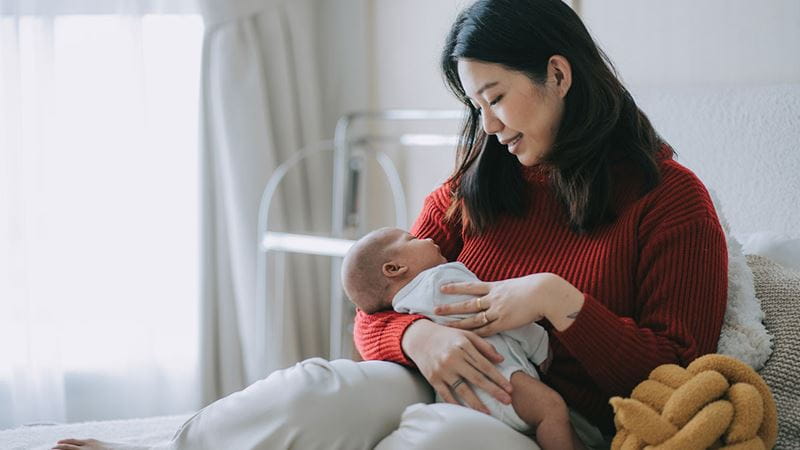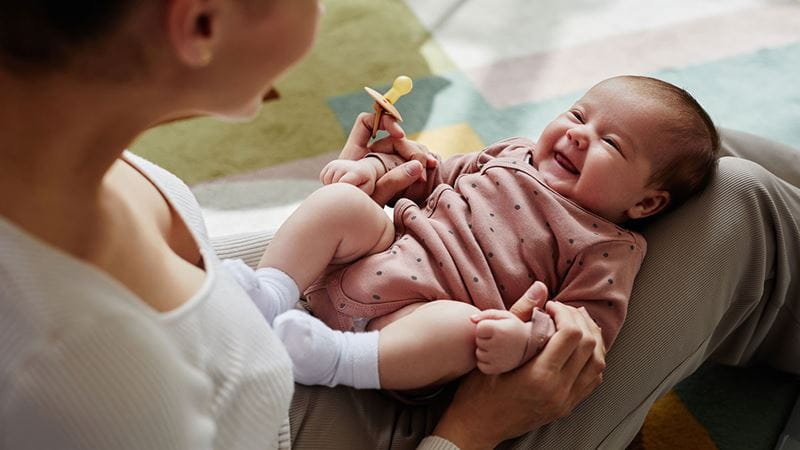Blog article
Your guide to newborn sleep

Whether your baby’s snoozing like a champ or refusing to sleep anywhere but your chest, this guide covers everything you need to know about newborn sleep, from how much they need, to safe sleep practices, settling tips, and what to expect in the months ahead.
How much sleep do newborns need?
On average, newborns sleep between 14 to 17 hours in a 24-hour period. Their sleep is spread out in short bursts of 2-3 hours, both day and night, because their small tummies need frequent feeding.1
Can a newborn sleep too much?
Newborns sleep a lot – and that’s a good thing. Sleep is essential for their growth, brain development, and emotional regulation. With some sleeping up to 20 hours a day, they put koalas to shame!2
As long as your baby is feeding regularly, there’s usually no need to worry about them sleeping “too much.” According to the Australian Breastfeeding Association, it’s common for newborns to feed 8 to 14 times in a 24-hour period. If your baby is waking for feeds, gaining weight, and seems alert during wake windows, their sleep patterns are likely just right.3
Creating a newborn sleep routine
While newborns aren’t quite ready for a strict schedule, gentle routines can help them feel secure and make sleep a little easier for everyone. Many babies respond well to a simple pattern of feed, play, sleep – especially during the day. After a feed, a short cuddle, some quiet play, or a little chat can help your baby wind down before settling to sleep.2
Unlike adults, newborns don’t yet have a sense of day and night, as the parts of their brain that regulate circadian rhythms are still developing.4 To help your newborns learn the difference between day and night, it’s recommended to keep things light and interactive during the day, and aim for a calm, quiet environment, with dim lights, soft voices, and minimal stimulation at night.2
How to get a newborn to sleep
Now that you’ve got your routine sorted, it’s time to actually get your newborn to sleep – which, let’s be honest, can sometimes make childbirth feel like a walk in the park!
Start with the basics: make sure your baby has had a feed, a clean nappy, and isn’t too hot or cold. Some babies settle easily, while others need a little help winding down. Some gentle settling techniques include:2,5
- Swaddling can help calm babies in the early weeks (until they start rolling). A safe sleep sack is a great alternative once they’re more mobile.
- Try rocking, patting, or stroking your baby while speaking or singing softly. Some babies prefer to fall asleep in your arms before being placed in their cot.
- If your baby is calm but drowsy, you can try hands-on settling – gently patting or stroking them in their cot until they drift off.
- Background noise like soft music or the hum of a washing machine can be surprisingly soothing.
- A dummy can help some babies settle, especially after the first six weeks when feeding is well established.
And yes, many parents find breastfeeding to sleep works wonders in the early months. It’s comforting, natural, and there’s no evidence it creates “bad habits”.6 If your baby becomes upset, it’s okay to pick them up, cuddle them, and try again once they’re calm. You’re not spoiling them, you’re helping them feel safe.
Safe sleep practices for newborns
Creating a safe sleep environment for your newborn is one of the most important things you can do. It helps reduce the risk of SUDI (Sudden Unexpected Death in Infancy), including SIDS (Sudden Infant Death Syndrome), and supports better sleep for both baby and parents.7
The safest place for your baby to sleep is in a cot or bassinet next to your bed, ideally for the first 6 to 12 months. The room should be smoke-free, and your baby should always be placed on their back to sleep, never on their side or tummy. Make sure the sleep space is firm, flat, and free of loose bedding, pillows, or toys.8
Check out our blog, Safe sleeping tips every newborn parent should know, for more information.
Can you safely co-sleep with a newborn?
Co-sleeping can feel comforting and practical, with many parents saying they sleep better with their baby close. However, the Western Australian Department of Health as well as organisations like Red Nose, strongly advises against co-sleeping due to increased risks of Sudden Unexpected Death in Infancy (SUDI). Other significant risks include infant suffocation, entrapment (where the baby gets trapped between the mattress and wall, for example) and falling out of bed.7,8
Therefore, while the safest place for your baby to sleep will always be on a firm, flat mattress in a cot that meets the current Australian Standard AS/NZS2172-2010, with no soft bedding, pillows, toys, or cot bumpers, if you do choose to co-sleep, it’s important to do it safely.
Safer co-sleeping tips:2
- Always place your baby on their back to sleep, never on their side or tummy.
- Keep their head and face uncovered. No pillows, blankets, or soft toys nearby.
- Use a safe sleep sack with fitted armholes and no hood.
- Tie up long hair and remove jewellery or dummy chains that could pose a risk.
- Make sure your baby can’t fall out of bed. Placing the mattress on the floor can help.
- Position your baby to the side of one parent, never between two adults or near pets or siblings.
It’s important to note there are some specific circumstances where co-sleeping can increase the risk of sudden unexpected death in infancy (SUDI), or sleep accidents. These include if:2
- You or your partner smoke, use alcohol, drugs, or medications that make you less responsive.
- You’re extremely tired, unwell, or your baby is premature or unwell.
What if my newborn only wants to sleep on me?
That’s totally normal! Newborns crave touch, comfort, and security, so it’s no surprise they often prefer sleeping on you. Your warmth, heartbeat, and scent help them feel safe – especially in those early weeks.
That said, it’s important to gently guide your baby toward sleeping in their own safe space. Using the settling tips and routine ideas above can help your baby learn to sleep independently over time. It won’t happen overnight, but with consistency and patience, it will happen.
How to dress a baby for sleep?
Babies sleep best when they’re dressed for comfort and safety. Instead of thick pyjamas, opt for layers of fitted clothing that you can adjust depending on the room temperature. It’s important to keep their head uncovered, as babies release heat through their heads and can quickly overheat if wearing hats or beanies during sleep.9
If your baby enjoys being wrapped, use a lightweight cotton or muslin wrap, making sure it’s not too tight and doesn’t cover their face. Once they start showing signs of rolling, switch to a safe infant sleeping bag or suit with fitted armholes and no hood.9
Can you give a newborn a dummy to sleep?
Yes, you can give a newborn a dummy to sleep once feeding is well established, usually after the first 4–6 weeks if you're breastfeeding. Dummies can help soothe babies and settle them to sleep, and interestingly, regular dummy use during sleep might even help reduce the risk of SIDS.10
Babies under six months should use dummies that can be sterilised, and it’s important to choose one that meets Australian Standard AS 2432:2015. Avoid dipping dummies in sweet substances and keep spares handy – once your baby loves their dummy, losing it can feel like the end of the world.10
How to get baby to sleep through night
The million-dollar question! If you’ve read the rest of this blog (rather than scrolling straight here), you’ll know that newborns simply aren’t wired to sleep through the night due to their regular feeding schedule.
That said, things do start to shift around the 6-month mark. Many babies begin having longer stretches of sleep, sometimes up to 6 hours at a time, and by 12 months, some are sleeping through the night or waking only occasionally.11
The good news? The routines and habits you’re building now, like consistent bedtime rituals, safe sleep environments, and responsive settling, lay the foundation for better sleep in the months ahead.


